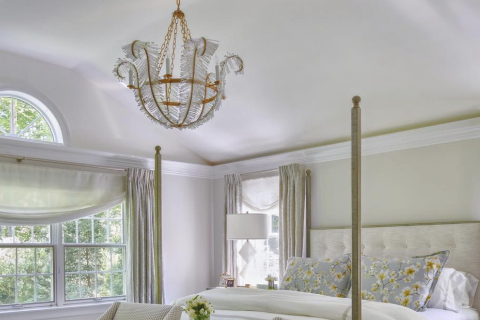The chandelier, a term derived from the French word “chandelle,” meaning candle, has a rich history that dates back to the Middle Ages. Initially, these ornate fixtures served a purely functional purpose: to illuminate large spaces, particularly in castles and churches. Early chandeliers were simple wooden frames adorned with candles, strategically placed to provide light in dimly lit rooms.
As the demand for more elaborate designs grew, artisans began to craft chandeliers from wrought iron and wood, often incorporating intricate carvings and embellishments. By the Renaissance period, chandeliers had evolved into symbols of wealth and status, with noble families commissioning grand designs that showcased their affluence. The introduction of glass, particularly crystal, in the 17th century marked a significant turning point in chandelier design, as it allowed for greater light reflection and refracted colors, enhancing the overall aesthetic appeal.
As time progressed, chandeliers Banlulu transitioned from mere sources of light to stunning decorative pieces that could transform a room’s ambiance. The Baroque and Rococo periods saw the emergence of opulent designs featuring elaborate crystal prisms and gilded metalwork, which became synonymous with luxury. By the 19th century, gas lighting further revolutionized chandeliers, allowing for even more intricate designs and larger installations.
The Industrial Revolution brought about mass production techniques, making chandeliers more accessible to the burgeoning middle class. Today, chandeliers are no longer confined to grand ballrooms or opulent dining rooms; they have found their way into various spaces, from modern homes to minimalist offices. This evolution reflects not only changes in technology and materials but also shifts in societal values regarding light, space, and design.
Choosing the Right Chandelier for Your Space: Size, Style, and Placement
Selecting the perfect chandelier for your space involves a careful consideration of size, style, and placement. The first step is to determine the appropriate size for your room. A chandelier that is too large can overwhelm a space, while one that is too small may go unnoticed.
A common guideline is to add the dimensions of the room (in feet) together and convert that sum into inches to find the ideal diameter of the chandelier. For instance, if your room measures 12 feet by 15 feet, a chandelier with a diameter of approximately 27 inches would be suitable. Additionally, consider the height at which the chandelier will hang; it should be positioned so that it does not obstruct views or impede movement while still providing adequate illumination.
Once you have established the right size, the next step is to select a style that complements your existing decor. Chandeliers come in a myriad of designs, from traditional crystal pieces that evoke elegance to sleek modern fixtures that embody minimalism. When choosing a style, consider the overall theme of your space—whether it leans towards rustic charm, contemporary chic, or classic sophistication.
Furthermore, placement plays a crucial role in maximizing the chandelier’s impact. In dining areas, for example, a chandelier should ideally hang about 30 to 36 inches above the table to create an inviting atmosphere without obstructing conversation. In living rooms or entryways, centering the chandelier in relation to furniture arrangements or architectural features can enhance visual balance and draw attention to the fixture as a focal point.
The Impact of Chandeliers on Interior Design: Creating a Focal Point
Chandeliers possess an innate ability to serve as striking focal points within interior spaces, drawing the eye and anchoring the overall design scheme. Their grandeur and presence can transform an otherwise ordinary room into an extraordinary one. When strategically placed in entryways or dining rooms, chandeliers not only provide illumination but also set the tone for the entire space.
A well-chosen chandelier can evoke feelings of warmth and hospitality or exude sophistication and elegance, depending on its design and placement. This transformative power makes chandeliers an essential element in interior design, as they can influence how a space is perceived and experienced by its inhabitants. Moreover, chandeliers can serve as conversation starters and artistic statements within a home.
In open-concept living areas, for instance, a bold chandelier can delineate different zones while maintaining an overall sense of cohesion. The interplay of light and shadow created by a chandelier’s design can add depth and dimension to a room, enhancing its visual interest. Additionally, with the rise of eclectic design trends that embrace mixing styles and eras, chandeliers have become versatile pieces that can harmonize with various aesthetics—from vintage to industrial to bohemian.
By thoughtfully incorporating a chandelier into your interior design scheme, you can create an inviting atmosphere that reflects your personal style while elevating the overall aesthetic appeal of your home.
Chandelier Trends: Modern Takes on a Classic Fixture
As design sensibilities evolve, so too do chandelier trends that breathe new life into this classic fixture. Contemporary chandeliers often embrace innovative materials and designs that challenge traditional notions of what a chandelier should be. For instance, many modern chandeliers feature geometric shapes and clean lines that align with minimalist aesthetics.
These fixtures may utilize materials such as metal or acrylic instead of crystal, offering a fresh take on illumination that feels both current and timeless. The use of LED technology has also revolutionized chandelier design; energy-efficient bulbs allow for sleeker designs while providing ample light output without compromising on style. Another trend gaining traction is the incorporation of mixed materials in chandelier construction.
Designers are increasingly blending wood, metal, glass, and even fabric to create unique pieces that reflect individual tastes and preferences. This fusion of materials allows for greater versatility in how chandeliers can be integrated into various design schemes—from rustic farmhouse kitchens to sleek urban lofts. Additionally, there is a growing emphasis on customizable chandeliers that allow homeowners to select specific components or configurations tailored to their spaces.
This trend not only empowers individuals to express their creativity but also ensures that each chandelier becomes a distinctive piece of art within their home.
DIY Chandelier Installation: Tips and Tricks for a Successful Project
Installing a chandelier can be an exciting DIY project that adds a personal touch to your home while enhancing its aesthetic appeal. However, it is essential to approach this task with careful planning and consideration to ensure safety and success. Before beginning the installation process, gather all necessary tools and materials—this typically includes a ladder, wire cutters, electrical tape, and a voltage tester.
It is also crucial to turn off power at the circuit breaker to avoid any electrical hazards during installation. If you are replacing an existing fixture, take note of how it is wired before removing it; this will serve as a helpful reference when connecting your new chandelier. Once you have prepared your workspace and gathered your tools, begin by securely mounting the chandelier’s base to the ceiling junction box according to the manufacturer’s instructions.
Carefully connect the wires—typically black (hot), white (neutral), and green or bare (ground)—ensuring that each connection is tight and insulated with electrical tape for safety. After securing all connections, gently lift the chandelier into place and attach it according to the provided guidelines. Finally, restore power at the circuit breaker and test your new fixture to ensure it functions correctly.
With patience and attention to detail, you can successfully install a stunning chandelier that elevates your space while enjoying the satisfaction of completing a rewarding DIY project.
Maintaining Your Chandelier: Cleaning and Care Tips for Longevity
To preserve the beauty and functionality of your chandelier over time, regular maintenance is essential. Dust accumulation can dull its shine and detract from its overall appearance; therefore, establishing a cleaning routine is crucial. Depending on the material—be it crystal, glass, or metal—different cleaning methods may be required.
For crystal chandeliers, using a soft microfiber cloth dampened with water or a gentle glass cleaner can effectively remove dust without scratching delicate surfaces. It is advisable to clean your chandelier every few months or more frequently if it is located in areas prone to dust or grease buildup. In addition to regular cleaning, periodic inspections are vital for ensuring your chandelier remains in optimal condition.
Check for loose crystals or components that may need tightening or replacement; this not only enhances safety but also maintains the fixture’s aesthetic integrity. If your chandelier uses bulbs that require replacement, opt for energy-efficient options such as LED bulbs that offer longevity while reducing energy consumption. By investing time in proper care and maintenance practices, you can enjoy your chandelier’s beauty for years to come while ensuring it continues to illuminate your space effectively.
The Versatility of Chandeliers: From Dining Rooms to Bedrooms, Finding the Perfect Fit
Chandeliers are remarkably versatile fixtures that can enhance various spaces throughout your home beyond traditional settings like dining rooms or grand entryways. In bedrooms, for instance, a carefully chosen chandelier can create an intimate atmosphere while serving as a stylish focal point above the bed or seating area. Opting for softer lighting options or dimmable features allows you to adjust brightness levels according to mood or time of day—transforming your bedroom into a serene retreat or an inviting space for relaxation.
Moreover, chandeliers can also find their place in unexpected areas such as bathrooms or home offices. In bathrooms, a small yet elegant chandelier can add a touch of luxury while providing adequate lighting for grooming tasks; just ensure it is rated for damp locations if installed near water sources. In home offices or creative spaces, unique chandeliers can inspire productivity while infusing personality into otherwise utilitarian environments.
By exploring unconventional placements for chandeliers throughout your home, you can discover new ways to elevate your interior design while enjoying the timeless elegance these fixtures bring to any setting.



